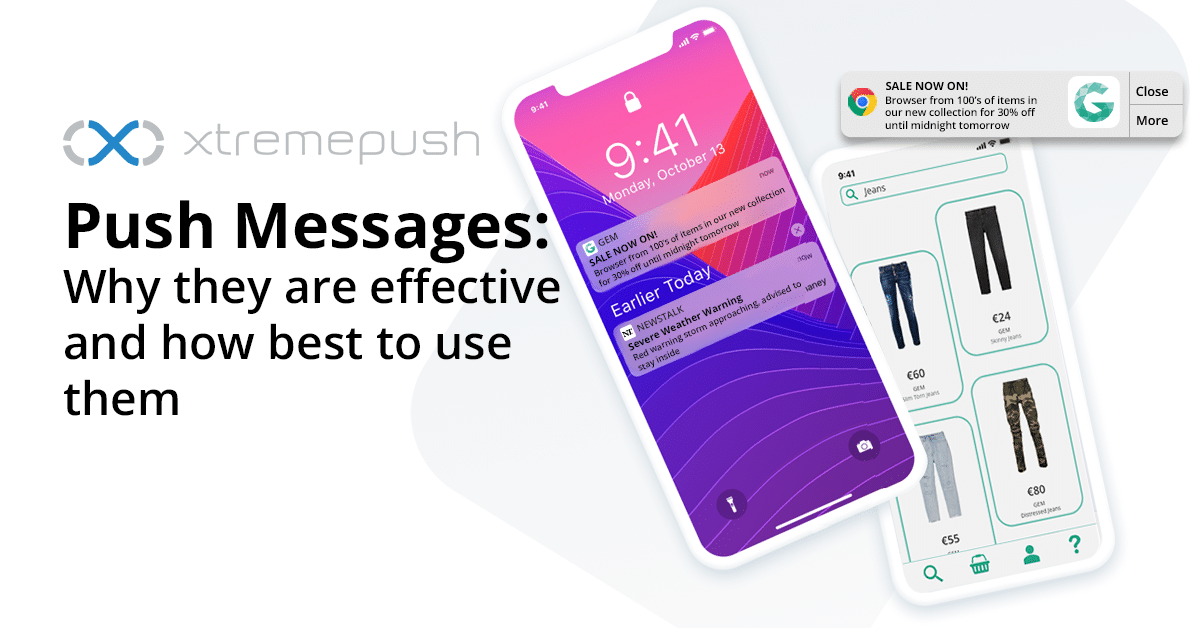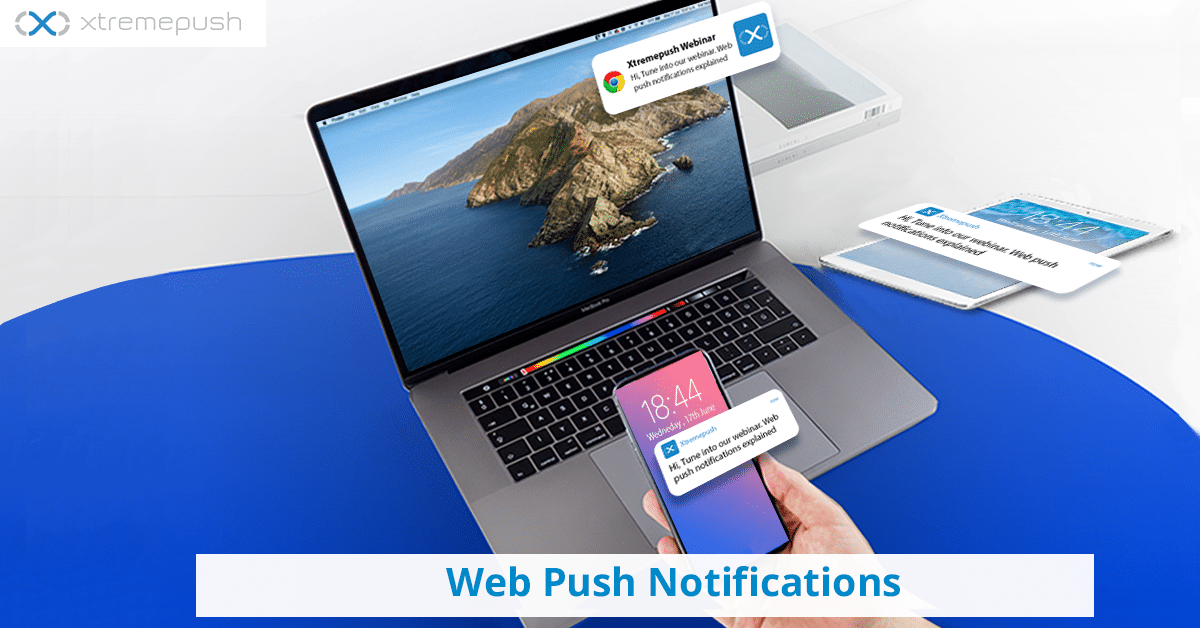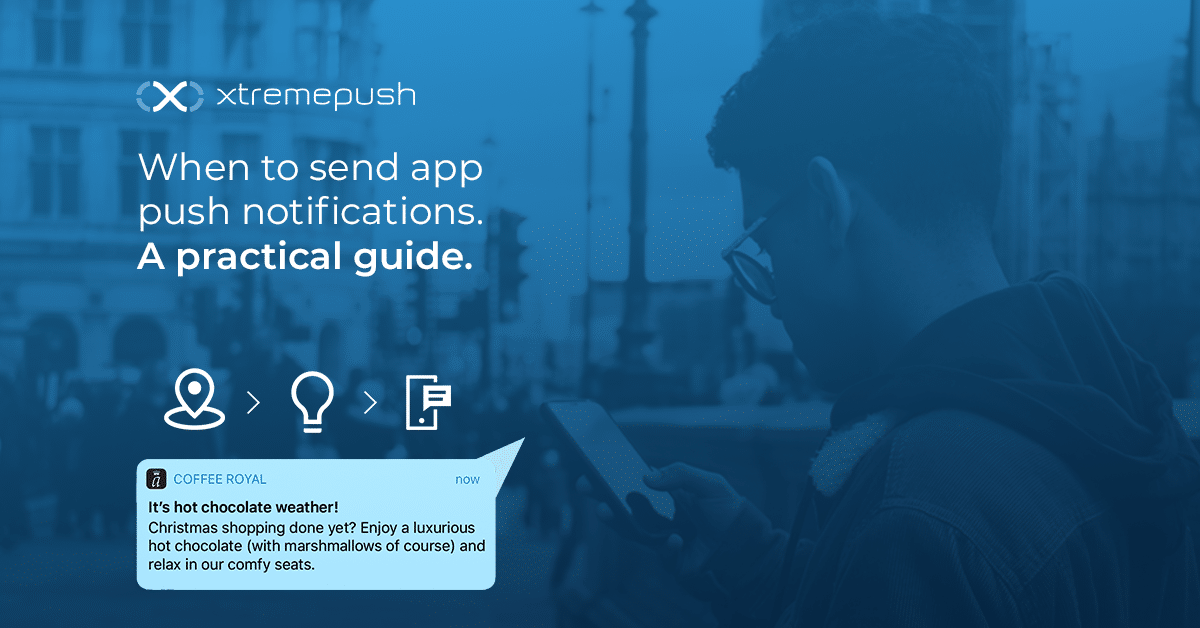What are Push Messages?
Push messages, more commonly known as push notifications, are short, branded communications sent to a customer’s device.
The goal of a push message is to capture your audience’s attention, share some informative or engaging piece of content, and encourage them to visit your website or open your mobile app to investigate it further.
In order to send and receive a push message, the recipient must have opted in and given consent to the brand. We cover this in more detail later on.
Unlike an email, push campaigns are delivered to, and viewed on, the device itself, and not within an inbox or some other 3rd party platform.
Mobile push messages vs web push messages
There are two types of push messages; mobile app push and web browser push. We won’t get into the weeds here dissecting the differences between them.
The key takeaway is that it’s possible to send push messages to both mobile devices (smartphones and tablets), as well as desktop and laptop computers (checkout this collection).
If you would like to learn more about each of them and explore the key differences between them, then we recommend checking out our detailed guide to push notifications.
Or if you are interested in focusing on one of them in particular then here are our guides to web push and app push respectively.

What are some use cases for Push Messages?
Simply put, if you have a website or a mobile app, then your brand will benefit massively from sending push messages.
If you have a mobile app and want to engage with people who have downloaded it, and encourage them to use it more frequently, push messaging is an absolutely essential channel.
And whilst web push appeared on the scene a few years later than the mobile push, its importance is just as acutely felt by brands in every industry.
The fundamental goal of any push campaign is to encourage the recipient to engage with it and navigate to your website or open your mobile app for further activity.
Once you have gotten this person on-site or within the app, you can continue the nurturing process and nudge them towards goal completion.
What that goal might actually be depends on both your brand’s business model and vertical, and where in the lifecycle the customer is.
Here are the three most common, archetypal push campaigns our clients send.
Onboarding and engaging new app users or website visitors
In the case of a mobile app, the drop-off rate for new downloaders is enormous.
If a user doesn’t open the app several times and have multiple, meaningful sessions (in terms of duration and/or activity) within the first week post-download, then the odds are that they will become dormant and eventually delete the app altogether.
And in terms of web traffic, the accepted statistic for conversions is that 90% of visitors don’t make a purchase on their first visit. So the goal should always be to find a way to get them back on-site a second time, at least, so that you can nudge them towards that all-important first purchase.
Given that the cost of acquiring a new user or visitor continues to rise, the way in which they are engaged with and nurtured is more vital than ever.
Push messages allow you to proactively connect with your audience and stimulate activity. And in the early stages of their relationship with your brand, these extra sessions will likely prove essential, helping to establish a pattern of regular interactions leading to repeat conversions.
Promoting products and driving revenue
Push messages have become an essential promotional channel for brands across every vertical due to their visibility and real-time delivery.
The more data you collect on your customers, in relation to their transactional history and browsing behaviour, the more targeted and impactful your push campaigns will become.
By creating multiple customer segments, dissecting your audience in terms of their specific interests and preferences, you have the ability to tailor your campaigns more precisely.
And the use of dynamic content ensures that the actual copy of each push message is individually relevant, populating it with specific data like a customer’s account balance, remaining loyalty points, an item on their shopping wishlist and so on.
This adds to the appeal and pull of the message, increasing engagement rates and driving traffic to your property.
Recovering abandoned carts
Amongst our own clients, we’re also seeing push messages being used to recover abandoned carts with incredible success. The ability to a/b test the timing of these campaigns is essential in order to identify the sweet spot for your brand and customers. The video below shows how a push campaign can be used to great effect when it comes to re-igniting an otherwise lost sale.
c
Want to learn more about how brands in your industry use web push notifications? Download our essential guide now!
How effective are Push Messages?
In terms of ROI and impact on revenue, below is a selection of results we’ve seen our clients drive using push messages.

For us at Xtremepush, we see two primary reasons why push messages are so effective; their visibility and their simplicity.
As a push campaign is a) received to a device while it’s in use and b) displayed prominently on-screen, you can be pretty much certain that the recipient will see it.
Contrast this with email, where you are typically competing for visibility with multiple other brands at the same time as the customer sorts through their inbox.
You have the ability to add images and gifs to make the notifications really stand out. And of course, as with all of the engagement channels we offer our clients, there’s a huge amount of personalisation possible to ensure that every push campaign you send is relevant to the audience and grabs their attention.

Secondly, although there’s a certain amount of skill behind an effective campaign, push messages are relatively straightforward to create and send. The formatting is restricted by the individual browser (Chrome, Safari etc) and the operating system (iOS and Android), so you don’t need to worry about that.
And you don’t need to worry about writing a huge amount of text either. In fact, a short, punchy headline and a brief message is what works best.
This makes it an ideal channel for communicating last-minute deals, or time-sensitive content that you want to get out to your audience as quickly as possible.
Wondering what practical steps you can take to maximise the performance of your push notifications? Check out our detailed guide to improving campaigns.
Opting in users for push messages
When it comes to using push messaging to drive results, the initial challenge for any brand is how to persuade their customers to opt in to receive them.
The first thing to say is that you should put your own personal feeling towards push messages to one side. It is fair to say that not everyone is a fan of them, and no more than you can’t expect all of your customers to subscribe to your email newsletters, it would be naive to assume the same about push.
However, the actual figures on this are pretty encouraging. Let’s start with web push. We typically advise new clients to expect somewhere in the region of 20% of their monthly website traffic to opt in for push notifications.
Not bad, right? If you could speak to one in every five visitors, and encourage them back to your website with a discount or enticing offer, you’d take it!
The situation with app push is slightly more complicated, but overall even more positive. Android users automatically give consent to receive push messages when they download a new app. They must actively opt-out. So, typically, you will be able to address +90% of your Android app audience immediately.
iOS users, however, must actively opt-in for push messaging. Depending on the vertical you’re in, and how persuasive your “value-exchange” is, you can expect in the region of 40% of your iOS users to give consent.
It’s important to understand that, for both app and web push, consent is tied to the device, not the customer themselves.
In other words, if a customer has two devices (let’s just say their smartphone and their desktop computer), in order to send push notifications to each of them, the customer would need to have opted in to receive them on each device individually.
This is by no means a problem, just something to be aware of.
Persuading people to opt in to push is a huge topic, with a lot of strategy behind it.
We’ll link to some more specific guidance and advice we’ve written on the subject, but for nowhere are the general rules of thumb.
-
Find the right moment to ask
Don’t feel that you have to ask users to opt in immediately, as soon they land on your website or open the app. In fact, we often see the best results come from brands who wait until the user’s session has lasted a specified amount of time, or until the user has visited multiple times.
Through trial and error, you can quickly work out what the best formula is for your brand and audience.
-
Nail the “value-exchange”
What’s in it for the customer? It’s obvious why you want them to opt in, but how will they benefit from this agreement? That’s the principle behind a value-exchange. We advise our clients to use what’s known as a “soft opt-in request”. Don’t worry too much about how that’s done right now, just remember to talk to your push service provider about it before you start working with them!
We’ve written detailed guides on how to get more opt-ins for app push and how to get more opt-ins for web push.
What’s next?
If you’re interested in learning more about the potential impact of push messages on your brand, then get in touch with us below for a personalised demo of our solution and the use cases we recommend you start with.
Xtremepush is a world-leading customer engagement, personalisation and data platform, working with hundreds of brands around the world to improve their communications and drive ROI at every stage of the customer journey













